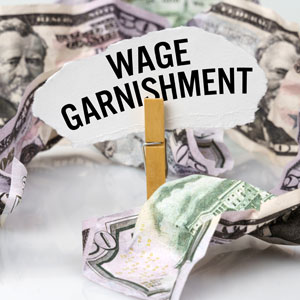 What Is Wage Garnishment? How Does It Work?
What Is Wage Garnishment? How Does It Work?
Wage garnishment occurs when a creditor obtains a court order to collect a debt directly from a debtor’s paycheck. This process typically follows a legal judgment against the debtor. Debtors often discover wage garnishment when they notice a reduction in their paycheck or bank account deposit, typically an unexpected and distressing experience.
Here’s a step-by-step explanation of how wage garnishment works:
- Judgment
The process begins when a person is sued for a debt, and the court issues a judgment in favor of the creditor. This judgment legally recognizes that the debtor owes the creditor a specific amount of money.
- Writ Of Garnishment
After obtaining the judgment, the creditor files for a writ of garnishment. This is a court order that directs the debtor’s employer to withhold a portion of the debtor’s wages to pay the debt.
- Notification To Employer
The creditor sends the writ of garnishment to the debtor’s employer. The employer is then legally obligated to comply and begin withholding a portion of the debtor’s wages from each paycheck.
- Withholding
Creditors garnish up to 25% of a debtor’s disposable earnings, which is the amount remaining after legally required deductions like taxes.
- Payment To Creditor
The employer sends the garnished wages directly to the creditor until the debt is fully paid off or the garnishment order is lifted.
How Can Chapter 7 Bankruptcy Stop Wage Garnishment?
Filing for Chapter 7 bankruptcy provides immediate relief from wage garnishment via an automatic stay and, upon successful discharge of the debt, ensures that the garnishment will not occur again. An overview of the process is as follows:
- Automatic Stay
When you file for Chapter 7 bankruptcy, an automatic stay is immediately put in place. This legal order halts most collection activities, including wage garnishment.
- Notification
As your attorney, I would then file proof of your bankruptcy with the court handling the lawsuit that led to the garnishment. This notification informs the court and the creditor’s attorneys that you are under bankruptcy protection.
- Direct Communication
I would then also email the creditor’s attorneys directly with proof of the bankruptcy filing to ensure they are aware of the automatic stay.
- Employer Notification
Once notified, the creditor must instruct your employer to stop withholding money from your paycheck. The employer’s payroll department will then cease the garnishment.
This process can take a week or two, but the garnishment will stop once the paperwork is processed and the employer receives the proper instructions. As long as your bankruptcy case proceeds smoothly and the debt in question is discharged, the wage garnishment will not resume. The debt that led to the garnishment will be eliminated through the discharge process.
Technically, wage garnishment stops immediately upon filing for Chapter 7 bankruptcy due to the automatic stay, but the practical cessation of garnishment usually occurs within one to two weeks due to the necessary administrative processes. Why? For a few practical reasons.
For starters, if your pay date is the day after filing, the payroll department might not have enough time to adjust your paycheck. In such cases, garnishment might still occur, but the garnished money will be returned to you.
Even with prompt notice to opposing counsel of your bankruptcy filing, they must take action to stop the garnishment. Incidentally, I advise my clients to inform their payroll department as well, which then must process the stop order.
If garnishment occurs on the day of filing or afterward, the garnished money must be returned to you. You won’t lose this money—it’s just a matter of the timeline for the adjustments to take effect.
What Are The Long-Term Effects Of Using Chapter 7 Bankruptcy To Stop Wage Garnishment?
Using Chapter 7 bankruptcy to stop wage garnishment can provide immediate and long-term financial benefits, especially if you can leverage it successfully. It does affect your credit report, but the elimination of debts and judgments will most likely far outweigh this point, offering a clearer path to financial recovery.
Know that it’s vital that you complete the bankruptcy process. If you file for bankruptcy solely to stop garnishment but do not follow through, your case may be dismissed, and creditors can resume garnishing your wages. It’s only when you’ve successfully completed the bankruptcy that debt is discharged, which, in turn, ensures garnishment will not resume for those debts.
A Chapter 7 bankruptcy will remain on your credit report for up to 10 years. This can make obtaining credit more challenging and potentially affect your ability to secure loans, mortgages, or other financial services. Once this time passes, though, things will become much easier.
The judgment that led to the garnishment will be eliminated from your credit report. The discharged debt will be marked as included in bankruptcy, and you will no longer owe the money, providing a fresh financial start.
Many people find that having a bankruptcy on their credit report is preferable to having a judgment. Judgments can lead to ongoing garnishments and additional legal actions, whereas bankruptcy provides a definitive resolution to your debt issues.
As you think through these issues in your own situation, consider the amount of debt you have and the cost of moving forward with bankruptcy. If you owe a relatively small amount, it might be more cost-effective to deal with the garnishment directly rather than incur legal fees for bankruptcy.
However, for many, wage garnishment is just one of many debts. In such cases, bankruptcy offers comprehensive debt relief, eliminating multiple debts and not just the garnishment.
Are There Any Alternatives To Bankruptcy To Stop Wage Garnishment?
Bankruptcy is undoubtedly a comprehensive solution to stop wage garnishment, but other alternatives, such as negotiating with creditors or filing a claim of exemption, may better suit your situation.
That said, these alternatives may not address the underlying debt and could only offer temporary solutions to your issues. Here are the primary alternatives:
- Allow The Garnishment
You can choose to let the garnishment continue until the debt is paid off. This may not be ideal for you, given it can cause significant financial strain.
- Negotiation
You can contact the creditor directly to negotiate a payment plan or settlement. Creditors might be willing to work out a deal to avoid the administrative costs and efforts of wage garnishment. This could involve agreeing to a lump-sum payment or a structured repayment plan.
- Claim Of Exemption
In Florida and many other states, you may qualify for certain exemptions that can stop wage garnishment. The most common exemptions include:
- Head Of Household
If you are the head of household and provide more than half of the financial support for a dependent, such as a child under 18, you may be exempt from wage garnishment. This exemption typically protects a significant portion of your wages.
- Social Security Income
If your income consists solely of Social Security benefits, those funds are generally exempt from garnishment.
I’ve been practicing bankruptcy law for a long time, and stopping wage garnishments is one of the primary reasons clients seek my help in this area. Facing wage garnishment is often the tipping point that compels clients to address their broader financial issues.
The relief they feel after the garnishment stops is tangible, and they are incredibly grateful. Even though the process of stopping a wage garnishment through Chapter 7 bankruptcy involves standard procedures and filing an extra document, it significantly improves their financial situation and peace of mind.
I once had a client who was a single parent supporting two children. The client’s wages were being garnished, and the financial strain was overwhelming. After we filed for Chapter 7 bankruptcy, the automatic stay immediately halted the garnishment. The client was able to retain the full paycheck, which was paramount for covering essential living expenses and providing for their children at the time.
While every case follows a similar legal process, each client’s unique situation reinforces the importance of empathy and clear communication. These cases aren’t just about filing the necessary documents but also about reassuring clients and guiding them through a very stressful period. In some ways, this emotional and psychological support is just as important as the legal assistance I provide.
For more information on Chapter 7 Bankruptcy Relief In Florida, an initial consultation is your next best step. Get the information and legal answers you are seeking by calling (407) 255-7458 today.



